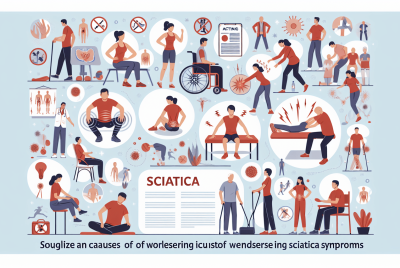Exercises To Alleviate Chronic Back Pain: A Step-by-Step Tutorial
Are you tired of living with chronic back pain? Look no further! In this step-by-step tutorial, we will guide you through a series of exercises designed to alleviate your discomfort and bring relief to your aching back. It’s time to take control of your pain and restore your quality of life. So grab a mat, find a quiet space, and let’s get started on your journey to a pain-free back!
1. Understanding Chronic Back Pain
What is chronic back pain?
Chronic back pain refers to persistent and long-term discomfort in the back, typically lasting for more than three months. Unlike acute back pain, which is temporary and often caused by an injury or strain, chronic back pain is an ongoing condition that can greatly affect a person’s quality of life. It is estimated that millions of people worldwide suffer from chronic back pain, and it can vary in intensity and location depending on the individual.
Causes of chronic back pain
Chronic back pain can have various causes, ranging from musculoskeletal issues to underlying medical conditions. Common factors contributing to chronic back pain include:
- musculoskeletal imbalances: Poor posture, weak muscles, and imbalances in the spinal structures can cause chronic back pain over time.
- Herniated discs: When the soft center of a spinal disc pushes through a crack in the outer casing, it can put pressure on the nerves in the back, leading to chronic pain.
- Arthritis: Degenerative conditions like osteoarthritis or rheumatoid arthritis can affect the joints and bones of the spine, causing chronic pain.
- Spinal stenosis: This condition occurs when the spinal canal narrows, putting pressure on the nerves and leading to chronic pain.
- Sciatica: Compression or irritation of the sciatic nerve, which runs from the lower back down through the legs, can cause chronic back pain.
The impact of chronic back pain on daily life
Chronic back pain can significantly impact a person’s daily life, affecting their ability to work, engage in physical activities, and even perform simple tasks. The constant pain can lead to decreased mobility, fatigue, and a decreased overall sense of well-being. Additionally, chronic back pain can have psychological effects, such as increased stress, anxiety, and depression, as individuals may struggle to cope with the limitations imposed by their condition. It is crucial to find effective ways to manage chronic back pain to minimize its impact on daily life.

2. Importance of Exercise for Back Pain Relief
How exercise can alleviate chronic back pain
Exercise has been widely recognized as an essential component of back pain relief and management. Regular physical activity helps to strengthen the muscles that support the spine, improve flexibility, and increase blood flow to the affected area. By doing so, exercise can alleviate chronic back pain through the following mechanisms:
- Strengthening muscles: Stronger muscles, particularly in the core and back, provide better support for the spine and help to distribute weight more evenly, reducing strain on the back.
- Improving flexibility: Stretching and range-of-motion exercises can increase flexibility, reducing stiffness and improving mobility in the back.
- Promoting blood flow: Engaging in aerobic exercises increases blood flow to the back, delivering oxygen and nutrients to the muscles and promoting healing.
Benefits of incorporating exercise into back pain management
Incorporating exercise into a back pain management routine offers numerous benefits beyond pain relief, including:
- Improved posture: Regular exercise can strengthen the muscles that support proper posture, reducing the strain on the back and promoting optimal alignment.
- Increased mobility: Stretching exercises can enhance flexibility and range of motion in the back, allowing for a wider range of movement and reducing the risk of future injuries.
- Enhanced mood: Exercise releases endorphins, also known as the body’s natural painkillers, which can improve mood and provide a sense of well-being, counteracting the negative psychological effects of chronic back pain.
- Weight management: Maintaining a healthy weight is essential for managing chronic back pain. Exercise can aid in weight loss or weight maintenance, reducing the stress on the back and minimizing pain.
Types of exercises that are effective for back pain relief
When it comes to back pain relief, various types of exercises have been found to be effective:
- Stretching exercises: These involve gently elongating the muscles to improve flexibility and relieve tension in the back.
- Strengthening exercises: These focus on building muscle strength, particularly in the core and back muscles, to provide better support for the spine.
- Aerobic exercises: These activities increase heart rate, promoting cardiovascular health and providing overall pain relief.
- Posture correction exercises: These exercises target specific muscles to improve posture and align the spine correctly.
- Mind-body exercises: These practices combine physical movement with mindful breathing and relaxation techniques to reduce stress and improve overall well-being.
By incorporating a combination of these exercise types into a well-rounded routine, individuals can effectively manage and alleviate chronic back pain.

3. Preparing for Exercise
Consulting with a healthcare professional
Before starting any exercise program, it is crucial to consult with a healthcare professional, such as a doctor or physical therapist, especially if you have chronic back pain. They can assess your specific condition, provide guidance on suitable exercises, and ensure that you are engaging in safe and appropriate activities for your level of fitness.
Assessing your pain level and limitations
Understanding your pain level and limitations is key to designing a personalized exercise program that effectively targets your chronic back pain. It is essential to listen to your body and avoid pushing yourself beyond your capabilities, as this can lead to further injury or exacerbate your pain. Assessing your pain level and limitations will help you choose the right exercises and modify them as needed.
Choosing the right exercise program
When choosing an exercise program for chronic back pain, it is essential to select one that suits your specific needs and preferences. Consider the following factors:
- Personal preferences: Choose exercises that you enjoy and are more likely to stick with in the long run. This will help you maintain consistency and stay motivated.
- Physical ability: Be realistic about your physical abilities and choose exercises that are suitable for your fitness level. Starting with low-impact exercises and gradually progressing is often recommended.
- Accessibility: Consider the availability of exercise facilities and equipment in your area. If you prefer exercising at home, there are several online programs and resources that can guide you through various exercises.
By taking these factors into account, you can choose an exercise program that is tailored to your unique needs and maximizes the benefits for your chronic back pain management.




